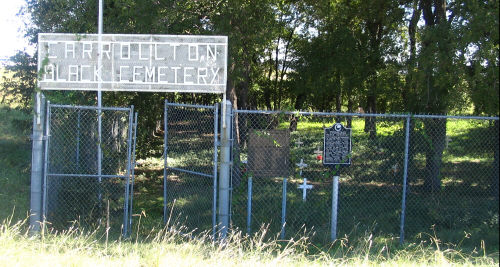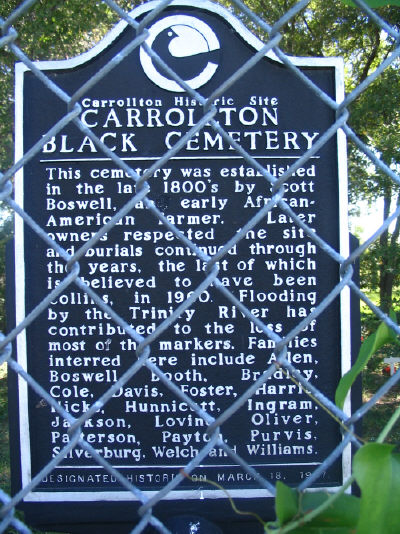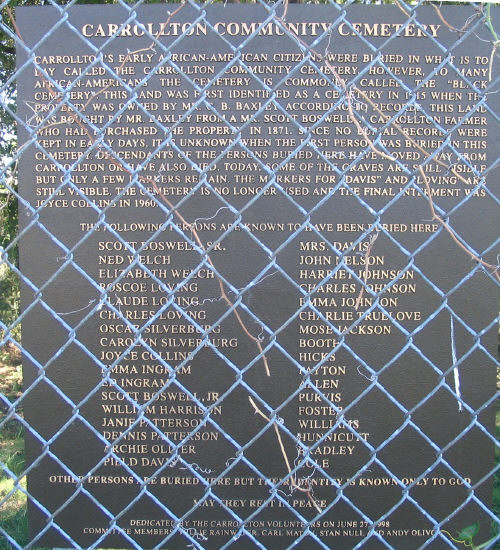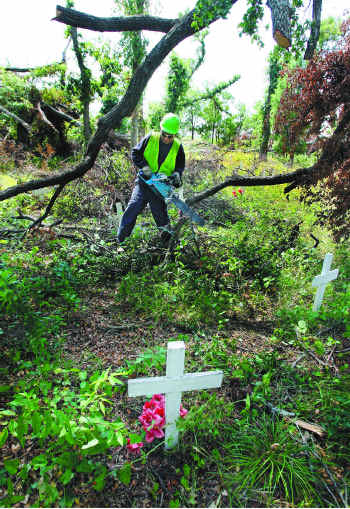|

Carrollton Black Cemetery Information:
Although dating back more than 100 years, this cemetery was not formally
dedicated until 1915. Despite periodic flooding, several gravestones are still
visible.
Location:
It is located approximately 1,000 feet west of Hutton Drive and 600 feet south
of Belt Line Road

Historical Marker Text:
Carrollton Historic Site
CARROLLTON BLACK CEMETERY
This cemetery was established in the late 1800's by Scott Boswell, an early
African-American farmer. Later owners respected the site and burials continued
through the years, the last of which is believed to have been Collins. In 1960,
flooding at the Trinity River has contributed to the loss of most of the
markers. Families interred here include Allen, Boswell, Booth, Bradley, Cole,
Davis, Foster, Harris, Hicks, Hunnicutt, Ingram, Jackson, Loving, Oliver,
Patterson, Payton, Purvis, Silverburg, Welch and Williams.
 |
| Carrollton's Earl African American citizens were buried in
what is today called the Carrollton Community Cemetery.
However, to many African Americans, the cemetery is commonly called
the "Black Cemetery". This land was first identified as a
cemetery in 1915 when the property was owned by Mr. C. B. Baxley
according to records. The land was bought by Mr. Baxley from a Mr.
Scott Boswell, a Carrollton farmer ho had purchased the property in
1871. Since no burial records were kept in early days, it is
unknown when the first person was buried in this cemetery.
Descendants of the persons buried here have moved away from
Carrollton or have also died. Today some of the graves are
still visible but only a few markers remain. The markers for "Davis"
and "Loving" are still visible. The cemetery is no longer used and
the final interment was Joyce Collins in 1960. The
Following persons are known to have been buried here
Scott Boswell, Sr.
Ned Welch
Elizabeth Welch
Roscoe Loving
Claude Loving
Charles Loving
Oscar Silverburg
Carolyn Silverburg
Joyce Collins
Emma Ingram
Ed Ingram
Scott Boswell, Jr.
William Harrison
Janie Patterson
Dennis Patterson
Archie Oliver
Pield Davis |
Mrs. Davis
John Nelson
Harriet Johnson
Charles Johnson
Emma Johnson
Charlie Truelove
Mose Jackson
Booth
Hicks
Payton
Allen
Purvis
Foster
Williams
Hunnicutt
Bradley
Cole
|
Other persons are buried here but their
identity is known only to God
May they rest in peace
Dedicated by the Carrollton Volunteers in June 27, 1998
Committee Members: Willie Rainwater, Carl Maton, Stan Null and Andy
Oliver
Other Possible Burials
Sammie Jackson (Dec 10, 1910 - Nov 6, 1927) per
Death Cert
Black cemetery's place in history commemorated with city marker
The Dallas Morning News-June 23, 2002
Author: SCOTT STAFFORD, Northwest Bureau
Some may have been slaves, their
descendants say, and all struggled to survive their times. They were
second-class citizens after the Civil War and before the Civil
Rights era.
They've been dead a long time, and, for a
while, their resting place was forgotten. But last weekend,
Carrollton officials, residents and descendants of the deceased
gathered at the Carrollton Black Cemetery to dedicate a city
historical marker - five years after the cemetery was declared a
historical site.
"The individuals that are buried here had
a lot to do with the growth of Carrollton," said Mayor Pro Tem Herb
Weidinger. "So it is important to commemorate the lives of those
buried here."
Participants at the recent event had a
chance to explore the cemetery, viewing the remnants of headstones
and stopping to read the inscription on the only one remaining: "Ned
Welch, 1834-1884. Our father has gone to a mansion of rest, to the
glorious land of the deity blest."
The great-granddaughter of Mr. Welch came
to the event. Gwen Turner, 64, is a resident of Richardson. She said
Mr. Welch and his wife, Elizabeth Miller Welch, had 13 children.
She said she believes Mrs. Welch rests in
the grave next to that of Mr. Welch. On the other side of his grave,
the base of a headstone reads "Loving." Ms. Turner said she thinks
that is the grave of Charles Loving, who married Mr. and Mrs.
Welch's daughter, Mattie, who is Ms. Turner's grandmother.
She said it is likely that Mr. Loving's
two infant children, who she said died in a house fire, are also
buried there.
Lone survivor
Mr. Welch's headstone faces what once
were grain towers in Old Downtown Carrollton, which is visible from
the cemetery. Mr. Welch once owned the land where the towers sit,
according to Jon Eric Simmons, a Carrollton resident and member of
the Dallas County Historical Commission.
Mr. Simmons said Mr. Welch was a farmer
and landowner when much of the Carrollton area was cleared and
farmed by black families.
He said Mr. Welch bought the grain-tower
site from the Perry family for $300 and later sold it to the Warner
family, who in turn sold it to another landowner for use as a
granary.
"This gentleman, Ned Welch, was one of a
number of successful black farmers who participated in land trading
up and down this area," said Mr. Simmons. "Because his tombstone is
still there, because some of his descendants still live in the
general area, and because the grain silo is such a noticeable site,
it shows that this man was fully engaged in the land trading and the
business activities of the growing farm community of Carrollton."
The history of the cemetery reflects the
history of the black community in Carrollton. Started in the 1870s
by black farmer Scott Boswell Sr. as a family burial site, it soon
became used by many members of the black community. Burials
continued for almost a century, the last occurring in 1960.
By the mid-1900s, the black community in
Carrollton was healthy, growing and vibrant, said Willie Rainwater,
a Carrollton resident whose great-grandfather, Pield Davis, is
buried in the cemetery.
"Black people were staying everywhere,"
he said, "and a lot of them were here before Carrollton even became
a city."
In the 1970s, the community started to
slowly dwindle as their farms and homesteads were sold off and
converted to other, mostly commercial uses.
During this time, as families sold their
lands and moved away, the cemetery drew fewer visitors and
eventually was overlooked. The land became overgrown and the graves
invisible.
It lay in the flood plain, and when the
Elm Fork overtook its banks, it took a toll on the gravestones. It
was also open to vandalism and theft.
In the late 1970s, according to Mr.
Rainwater, Carrollton City council member Dick Walker told his
mother, Annie Heads Rainwater, that a developer was interested in
purchasing the old Boswell farmland, including the cemetery, and
intended to bulldoze the site.
A 1980 lawsuit resulted in the state
recognizing the cemetery and prohibiting any construction that would
disrupt the site, said Chris Barton, chief planner for Carrollton
and staff liaison to the Carrollton Historic Preservation Advisory
Committee.
"It is a blessing they saved it, because
these people were Carrollton's foundation," Mr. Rainwater said at
the ceremony.
Years of effort
Occasionally, volunteers would gather to
cut down the weeds and maintain the grounds. A barbed wire fence was
replaced with a chain link fence and a sign reading "Carrollton
Black Cemetery" over the entrance.
Later, after years of working as a member
of the preservation committee, Mr. Rainwater's efforts were
rewarded. The Carrollton City Council finally designated the
cemetery historic on March 18, 1997.
In June 1998, members of the community
erected a sign, paid for with contributions. It listed many of the
people buried in the cemetery and recounted some of its history.
Volunteers installed white wooden crosses
to mark the graves that could be found. But the preservation
committee struggled with the placement of the official city
historical marker.
Mr. Barton said the city's historical
signs are usually placed on public property where people can safely
park to view the sign and site. Since the cemetery is in the middle
of a prairie, that wasn't possible. They decided to wait, hoping
someone would develop the land and provide better access.
After a number of years, Mr. Rainwater
pointed out that the city had waited long enough, and the
preservation committee agreed.
Ms. Turner is grateful that the cemetery
has been preserved.
"It means a great deal to me and to my
family."
At the same time, she said, she regrets
that so much of the cemetery has been lost.
"I feel a great deal of empathy for those
families. Not being able to stand at the spot and say this is where
my relative is, is a loss for them."
Dallas Morning News - June 23, 2002
Nature, neglect take toll on black settlers'
cemetery in Carrollton
12:00 AM CDT on Friday, July 11, 2008
By STEPHANIE SANDOVAL / The Dallas Morning News
[email protected]
|
 LOUIS
DeLUCA/DMN LOUIS
DeLUCA/DMN
A worker cleared trees and branches Thursday at Carrollton
Black Cemetery. Much of the damage occurred during an April
storm, but the cemetery was already overgrown with grass and
weeds. |
Not much is left to mark the final resting spots of Carrollton's
earliest black settlers. But they left their mark on the city, says
resident Willie Rainwater.
"They set the foundation for us to be where we're at now. ... They built
Carrollton," he said. "Black people are the ones that laid all the
bricks. The cement was poured by black people."
Lest they be forgotten, every year Mr. Rainwater and a group of
volunteers cut weeds and clean up Carrollton Community Cemetery,
also known as Carrollton Black Cemetery.
But Mother Nature thwarted them this year. An April storm that
ripped down trees and fences across town left the historic cemetery,
already overgrown with grass and weeds, a shambles.
"There are some tops of the trees that have been blown off, and
they're suspended above the property by other limbs," said Brian
Passwaters, the city's community services manager. "Other limbs are
down on the ground. It creates a harborage for rodents, for coyotes
and other animals we have in the area. ... It could be a danger out
there."
The cemetery sits on a roughly 22-acre undeveloped tract owned by a
bank in Houston. But the city has been unable to get the bank to mow
it. Several times, the city has had crews mow a 50-foot-wide strip
around the property, placing a lien on the land in hopes of someday
recovering its costs.
The cemetery, however, sits in a dell in the interior of the tract.
And because regulations don't require mowing there, the city has
largely left it alone.
About the only maintenance the cemetery has received has come from
volunteers with Christ Community Connection, said Mr. Rainwater,
whose great-grandfather Pield Davis is buried there. The group
usually goes out around Juneteenth.
But because of the storm damage, Mr. Rainwater notified city
officials, and representatives from the parks and code enforcement
departments visited. The city sent a crew to clear the limbs
Thursday.
The cemetery was established in the late 1800s, and the last burial
is believed to have taken place in 1960. Many buried there are
believed to have come to the area as slaves.
The site is in the floodplain of the Elm Fork of the Trinity River,
according to the Dallas County Historical Commission, and
floodwaters have washed away all but two of the tombstones, leaving
only one of those intact.
In the late 1970s, a developer expressed interest in buying the land
that includes the cemetery and bulldozing the site. But a 1980
lawsuit halted that plan, bringing state recognition for the
cemetery and prohibiting construction that would disrupt the graves.
In the late 1990s, volunteers installed uninscribed white wooden
crosses to mark the graves that could be found. And in 2002, a city
historical marker was dedicated on the site.
Mr. Rainwater hopes the city will help drum up community support for
continuing upkeep.
The cemetery is special to him, not only because his ancestors are
buried there but also because it holds the remains of others who
helped make Carrollton a community.
"It should mean a whole lot to the whites and to everyone else,
because they built the foundation of all of it," Mr. Rainwater said.
"We really can't afford to lose the history."
|
Carrollton
Volunteers Clean Up Old Black Cemetery for Juneteenth
Diane Jennings
Jun. 20--Standing in a patch
of shade at Carrollton's
historic black cemetery, Gwen Turner
couldn't help but wonder what her great-grandfather, Ned Welch, would have
thought of the crowd gathered there this morning.
His tombstone, erected after his death in 1884,
is one of the last original markers in the small graveyard.
"I can just imagine he would be elated people
thought enough of this little cemetery to come out and maintain it," she
said.
Turner was
one of about 70 people who showed up early today, armed with rakes and hoes,
clippers and saws, for the annual cleanup. They trimmed trees, bagged dead
grass, painted crosses and placed red, white and blue flowers atop each
grave.
For many in the crowd, both black and white, it
was especially meaningful that the event fell on Juneteenth, the state
holiday that celebrates the day news of the emancipation of slaves reached
Texas.
Serita Wright of Lewisville
wasn't familiar with the holiday when she moved to Texas from Virginia 10
years ago. "I couldn't figure out why June 19th was a big day," she said
with a laugh.
In addition to helping at the cleanup, she
planned to observe Juneteenth by attending a crawfish boil later in the day.
"Why am I here?" she said.
"It's to pay tribute to the people that rest here."
Despite the summer heat, Wright said, giving up
a Saturday morning to paint anonymous crosses was not a big sacrifice.
"When I think about my ancestors out there, it
was probably hotter than it is now and there were no cell phones, no air
conditioning, no comfy mattresses," she said.
John Conn, a self-professed
history buff, also thought about those who endured a Texas summer 150 years
ago, when the cemetery was founded. "This little bit of raking is nothing
compared to picking cotton," he said. "Imagine what they went through."
Conn, who like many at the
event, is white, mused that perhaps he was trying to "make amends."
The army of workers
represented the biggest turnout in the cleanup's 12-year history, said
Carrollton civic leader
Willie Rainwater, whose mother helped save the cemetery from being plowed
under 20 years ago. Like Turner's,
Rainwater's ancestors are buried in the graveyard.
Rainwater, who throughout
the year helps maintain the small plot of land encircled by a chain link
fence, said only two or three people showed up in the cleanup's first year.
But today, as insects hummed and traffic rumbled by on a freeway not far
away, dozens of people, including Carrollton
Mayor Ron Branson, fanned out across the graveyard.
Most of the cemetery's
original tombstones or markers have been washed away by floods or stolen.
Except for Ned Welch's handsome tombstone and a handful of others, the dead
are marked now by simple white crosses.
Two markers tell visitors
about the history of the cemetery. When Rainwater announced that a state
marker would be added soon, the crowd cheered.
"This is what it's all
about," he told the crowd after a local Boy Scout troop raised the flag and
the crowd recited the Pledge of Allegiance. "People sharing love. We've come
a long way in this community."
Juneteenth celebrations also
have come a long way. Though Texas is the only state to declare it an
official holiday, observances are now held in many places across the
country. President Barack Obama even issued a statement about the holiday's
significance.
"Our nation is stronger
because of the generations of struggles for equal rights and social
justice," Obama said. "And our culture is richer because of the
contributions of African-Americans throughout our history. This is why
Juneteenth, while rooted in the history of a people, can be celebrated by
all Americans."
Marker Photos:
Obituaries:
|
![]() Carrollton-Farmers
Branch TXGenWeb
Carrollton-Farmers
Branch TXGenWeb


 LOUIS
DeLUCA/DMN
LOUIS
DeLUCA/DMN